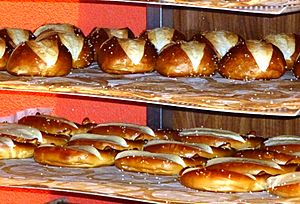Lye roll facts for kids
 |
|
| Type | Bread roll |
|---|---|
| Main ingredients | Bread roll, solution of lye or baking soda |
Lye rolls are a special kind of baked bread roll. They are very popular in countries like Germany, Austria, Switzerland, and parts of France.
These rolls get their unique look and taste because they are dipped in a special liquid called a lye solution before they are baked. This dipping process gives them a shiny, dark brown crust and a soft, chewy inside.
In Germany, these baked goods are called Laugengebäck. The most famous one is probably the pretzel. But there are many other shapes too! For example, rolls might be called Laugensemmel or Laugenbrötchen. In Switzerland, they are sometimes known as Silserli.
In France, especially in the Alsace region, a lye roll is called a mauricette. It was first made by Paul Poulaillon in 1973. Later, it was also known as Moricette.
Why Lye Makes Them Special
Lye rolls have a special brown color and a unique taste. This happens because of something called the Maillard reaction during baking. To make this reaction happen, the roll needs to be covered in a liquid that is very alkaline.
Think of it like a scale: some liquids are acidic (like lemon juice), and some are alkaline (like soap). This "alkaline" level is measured by something called pH. The higher the pH, the stronger the reaction will be.
Lye, which is also known as sodium hydroxide, is a very strong alkaline liquid. It's the most common thing used to dip these rolls.
Safer Options for Dipping
Lye is strong, so it needs to be handled carefully. But there are other, safer ways to get a similar effect!
You can use a solution made from baking soda or washing soda. These are much easier and safer to use at home. They will still give the rolls a nice brown color, but the effect might not be as strong as with lye.
Lye gives the strongest browning, followed by washing soda, and then baking soda. Pretzels are also often dipped in the same kind of lye solution.
How Lye Rolls Are Enjoyed
Lye rolls and pretzels are usually topped with salt. A special kind of salt called pretzel salt is often used. It has large grains and doesn't get soggy easily.
Sometimes, lye rolls are made into sandwiches. You might also find them with baked cheese on top, though this is a newer idea. A very common way to eat them is to cut them in half and spread butter inside.
Besides salt, other toppings like poppy seeds, sesame seeds, or other seeds are sometimes used.
In Germany, lye rolls come in many different shapes and sizes. For example, a Laugenstange is a long, oval roll. A Laugenbrötchen is a smaller, round roll. Each shape often has its own unique name!
See also
 In Spanish: Laugengebäck para niños
In Spanish: Laugengebäck para niños


